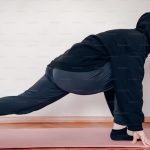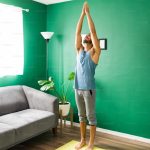Are you a more mature person, maybe in the autumn of your years ? Have you heard how yoga is SO good for you but wish you’d known this 10 / 20 / 30 or more years ago because then you were young enough to give it a try? And now it is surely too late because you are 50 / 60 /70 /80 years old… Wrong! It is SO not too late – in fact it is never too late to start yoga.
Actually NOW is the perfect time for you to try yoga because yoga is about movement and breath. It is about how your body responds to what you do NOT what your body looks like when you do it. So, it does not matter that you are unlikely to ever rock the iconic single leg balances. Or that you would be unwise to start with a handstand. If you can move and are still breathing then yoga is for you!
Yoga Basics
It is important to keep safety in mind when anyone is starting out on a new activity and yoga is no different. There are a few simple rules that you would be wise to keep in mind as you embark on your yoga journey.
- Yoga does not hurt – never allow a pose to cause pain or pinching sensations. If it hurts – you are pushing too hard OR that pose is not good for your body. So move on, try something else.
- A bit of stretch is good – a mild sensation of stretch in the body is good as long as it eases or stays the same as you hold a pose. If it increases you are pushing too hard – ease off until you are comfortable again.
- Little and often is the secret – especially when you are starting out, a few minutes of yoga each day is better than trying to do longer sessions less often. Maybe aim for 5 minutes 5 days a week to start with and then build up if you want to.
- There is no ‘best’ time of day to do yoga – Some people love to start the day with their yoga, others do it last thing at night and it helps them sleep. Some love morning practice, others swear by afternoon yoga. Try different times of day to see what suits you. I would recommend not straight after a meal though – best to wait an hour or two after the main meal.
- You don’t need ‘yoga clothes’ – any loose-fitting clothes that allow you to move freely are perfect for yoga.
- Good yoga makes you feel good – if something does not feel good – park it and move on. Don’t struggle with things that don’t make you feel better. Most people feel good after even a few minutes of yoga.
So, you are ready to give it a go – but where to start? How about where you are right now… I suspect you are sitting reading this, right? And sitting is the perfect place for seniors to do yoga. It is safe and stable and we do a lot of it. Ideally find a firm, upright chair if you can – if not, sit on whatever chair you have.
So, here we go – may I introduce the Super Six for Senior Yogis!
-
DEEP BREATHING
Many people only use a small part of their lungs when they are breathing. Unless you do enough exercise to get out of breath then you are probably not using the bottoms of your lungs very much. This exercise opens up those lung bases and helps to make our breathing more efficient in everyday life. In addition, slow deep breathing stimulates the calming side of the nervous system. This, in turn, has a whole range of beneficial effects on the body – including reducing the release of stress hormones; lowering heart rate and blood pressure; improving sleep and helping us to manage stress and stress-related problems. And it is SO simple to do.
Sit up straight with weight equally on both buttocks. Place feet flat on the floor if possible. Grow tall through the crown of the head so you are sitting up tall. Hands can be resting on the legs or over the upper belly. Take a deep breath in through your nose and push the air deep into the base of the lungs. When you are ready, breathe out through your nose or mouth – your choice here. Make the breaths as slow as comfortable and avoid holding the breath at any point. Let each breath flow into the next with minimal effort.
As you practice this, you may notice that the upper belly swells forwards as you breathe in and softens as you breathe out. This is because you are using your diaphragm to suck air into the chest and it squashes your abdominal contents as it does it – this is what makes the upper belly bulge forwards with each breath. Try focusing on that upper belly movement as you breathe. Even one or two deep breaths brings health benefits and there is no limit to how many you can do if you like them.
2. SEATED STAFF POSE
This is a lovely pose for activating muscles early on in a yoga sequence. Again, sit with weight equally on both halves of the bottom and feet flat if you can. Press down through the feet and buttocks as you grow tall through the crown of the head – feel the spine lengthen here. Squeeze the thighs together with a little and gently scoop the belly towards the spine (as if you are trying to get tight trousers done up). Squeeze the shoulder blades gently together and towards the waist to open the chest and draw the shoulders away from the ears. Keep looking straight ahead and take about 5 slow, deep breaths – hold the muscle action until you exhale the last breath.
3. SEATED CAT AND COW
This is really nice for getting movement in a stiff spine – here’s how. Shuffle forwards a little so that your back is not against the back of the chair – still stay firmly on the seat though, not teetering on the edge. Exhale as you drop your chin on to your chest then roll the spine down into a slouched position allowing the pelvis to roll backwards as the spine curls up. Inhale to uncurl again by arching the back forwards and drawing shoulder blades together – this sticks the chest and belly forwards as the shoulders go back. Repeat 4 or 5 times – more if it feels nice.
You can try rolling up and down starting from the top first (as above) or from the bottom up then down again – try it for some variety.
4. SEATED TWISTS
Twisting is a natural movement that we do a lot when we are younger but much less as we get older. Twisting in sitting is a great way to regain the range of movement in a safe and secure way which will then increase confidence in twisting more naturally as we move around. Start by sitting up tall with a long spine. Place the right hand on the outside of the left thigh – as close to the knee as you can reach without stooping forwards. Then put the left hand on the left side or back of the chair by your bottom. Inhale to sit tall with a strong spine. Then exhale to turn the head and body to the left. Hold for 3 or 4 breaths then return to the start position. Repeat to the other side by placing the left hand on the outside of the right thigh and twisting to the right. Aim to keep both knees level and pointing forwards – they will want to twist with the body if you push too far.
5. ARMS OVERHEAD
This one helps to get your spine and shoulders moving as well as stimulating the calming side of the nervous system. Take a big breath in and lift both arms overhead – see if they will touch. When you are ready to breathe out, lower the arms down. . Watch the hands as they lift and stretch as far as you can comfortably. If your arms go comfortably overhead – try arching the spine back a little to add a spinal stretch to the exercise. If your chair allows it, you can try this with the arms going out to the side OR forwards. Repeat 5-10 times in time with slow deep breaths.
6. SEATED SUN SALUTES
Sun salutes are a flowing sequence that helps to warm up the soft tissues (fascia) and make them more flexible. The bending and stretching of the spine also help to nourish the spinal discs, often making stiff, sore spines more comfortable. Sun salutes are a great way to wake the body up and get it ready for the day ahead. Traditionally they are done before breakfast, to welcome the sun as it rises, but are just as good done anytime throughout the day. Having said that, they are best avoided in the evening and before bed because they are energising and may disturb your sleep.
Sit tall as in seated staff pose above for a few deep breaths. Then inhale arms overhead and stretch hands towards the ceiling. Exhale to lower arms and place hands on knees. Inhale to straighten elbows and lift chest up and forwards for a moment before exhaling again to bend forwards and slide hands down legs towards feet. Inhale to sit back up to start position. Take a couple more deep breaths then start all over again, lifting arms overhead on a deep breath in. Repeat 3-5 times if comfortable.
This sequence is about movement rather than stretching so start REALLY gently and move further into each pose only if it is getting more comfortable with each repetition.
The Benefits of Yoga
A little yoga goes a long way – even a few deep breaths have the potential to make you feel better. A bit of movement every day can help to bring back some of the strength and flexibility that we lose as we get older. You may notice that you are standing up straighter. Or maybe finding reaching for things easier. Maybe dressing and washing will be less of a problem. You might sleep better – or feel more awake during the day. You may simply enjoy the activity! No matter what it brings you – yoga is safe and accessible. Give it a go – I think you’ll be glad you did.












